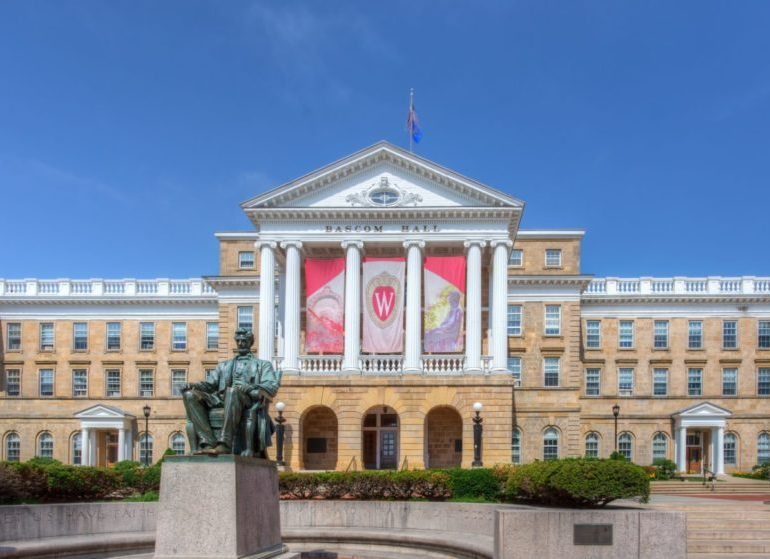The University of Wisconsin System and UW-Madison have not kept pace with their peers nationally in key funding areas due to the state’s tuition freeze, stagnant funding and declining enrollments over the past decade, according to a new Wisconsin Policy Forum report.
Those challenges, exacerbated by COVID-19, could lead to more faculty cuts, reduced programs and additional debt for the UW System and its flagship campus if they don’t find new revenue sources, the report said.
“After years of slow erosion of funding and enrollment, higher education in Wisconsin faces a flash flood,” the report said.
The report details how the state’s public higher education system has lagged other universities in the region and nation over the past decade, including:
- Wisconsin ranks 41st-lowest nationally and last in the Midwest for its adjusted total revenues from state and local funding as well as net tuition in 2019. That’s down from 24th-highest nationally in 2000, according to the report.
- Between 2000 and 2019, adjusted state and local funding per full-time equivalent student at Wisconsin universities and technical colleges fell from 6.4% above the U.S. average to 16.5% below that average ($6,846 here versus $8,196 for the U.S.).
- Since their peak in 2010, full-time equivalent enrollments at the UW System fell by 8.4% to 142,907 in 2019.
- In-state undergraduate tuition rates have remained frozen since 2013. Prior to that, in-state undergrad tuition more than doubled at every four year-campus between 2001-2011, including a 141% rise at UW-Madison. In 2013, UW-Madison’s revenues per full-time student were $21,295, 17th among its peer group. By 2018, it dropped to 23rd among its peers, at $22,730. “This trend was positive for families and taxpayers in terms of their costs but may have affected the quality of education received,” the report said.
The WPF report was commissioned by Badgers United, a group formed to support UW-Madison that includes several prominent Milwaukee-area executives.
Declining faculty numbers and R&D spending, in particular, could hurt the UW System and UW-Madison’s national reputation, the report said. Between 2000 and 2019, UW System faculty fell from 6,103 to 5,675. UW-Madison’s faculty numbers remained largely flat, despite an increase in student enrollment, with faculty salaries lagging. Meanwhile, UW-Madison has increased its R&D spending in recent years, but its national rank has dropped from third-highest R&D spending in the nation in 2010 to eighth-highest in 2018.
COVID has layered on those existing challenges, according to the report. The UW System estimated in June a net loss of $158.6 million after factoring in lost revenues, higher costs, spending cuts and federal aid, with most of it falling on UW-Madison. UW-Madison said it was extending employee furloughs and pay cuts to close a $320 million budget gap in 2020 and 2021 due to increased costs and lower revenues from tuition, research funding, and athletics and other self-financing units, the report said.
Wisconsin’s public universities also have fewer reserves to cope with the crisis, with tuition balances for the UW System including UW-Madison having declined by 58.8% since 2013, the report said. It also contends that UW System’s governance structure – which includes less autonomy from state leaders compared to its peers – may leave the system and UW-Madison with less flexibility to respond to the crisis.
The report offers some possible solution to the UW System’s challenges, including “increasing state tax or student tuition funding for higher education; securing other sources of revenue; enhancing borrowing options; shoring up sagging enrollments; and finding efficiencies through digital learning, new flexibility for campus leaders, or streamlined programs, campuses, or governance.” The report does not advocate for any one approach.
“While no one would have invited the current crisis, its impact on Wisconsin’s economy and finances may provide the strongest impetus yet for state policymakers, higher education leaders, and the vast array of college and university stakeholders to chart a better course for the state’s system of post-secondary education,” the report said.
It also notes a few positive trends, including improved graduation rates across the state’s public four-year institutions, including among underrepresented minorities.
However, the state still has the nation’s largest six-year completion gap between black and white university students at public four-year institutions, according to National Student Clearinghouse data. Four Milwaukee-area higher education institutions (UWM, UW-Parkside, Milwaukee Area Technical College and Carthage College) recently announced plans to eliminate the graduation gap between white students and students of color by 2030.


